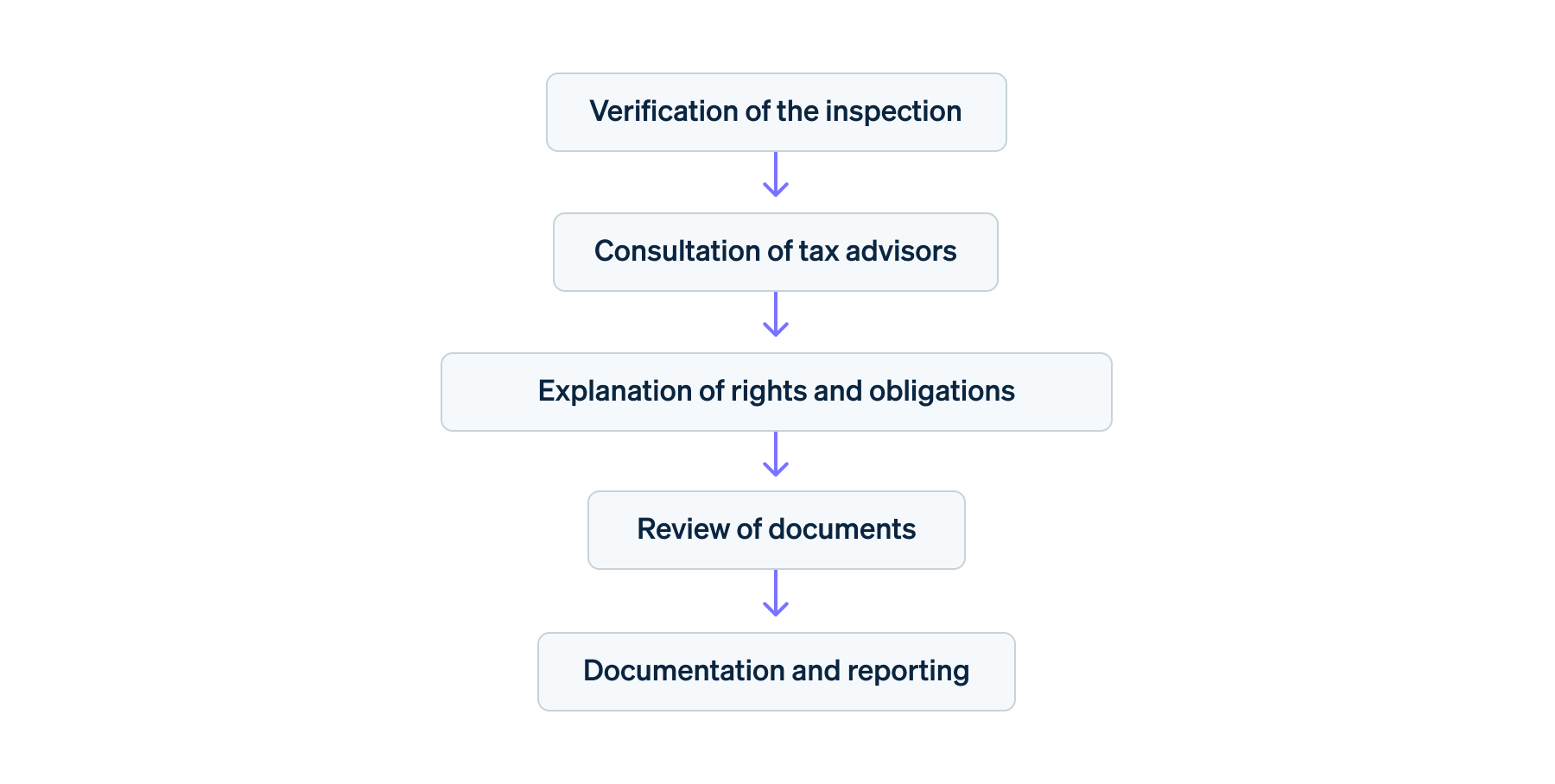为确保企业遵守增值税 (VAT) 义务,税务局可以进行增值税检查。在本文中,您将了解什么是增值税检查,以及在哪些情况下税务局可以组织增值税检查。我们还解释了流程,描述了可能的后果,并提供了有关如何最好地准备增值税检查的提示。
目录
- 什么是增值税检查?
- 税务局何时进行增值税检查?
- 增值税检查如何进行?
- 增值税检查的可能后果是什么?
- 企业如何准备增值税检查?
什么是增值税检查?
增值税检查是德国税务机关用来检查企业是否遵守增值税义务的措施。这是一项突击审计,在此期间,税务机关授权官员在营业和工作时间进入企业的物业和建筑,以检查其商业文件和与增值税相关的文件。与常规业务审计不同,增值税检查不涉及对整个业务的全面审查,而是涉及具体的增值税问题。
增值税检查与增值税特别审计不同,增值税特别审计由税务机关提前通知且无需特定理由即可开展。此外,特别审计通常侧重于个别问题或特定时期。检查不一定是这种情况:税务官员可以无限期地审查增值税事宜。增值税检查的法律依据是增值税法第 27b 条 (UStG)。
税务局何时进行增值税检查?
如果有迹象表明企业未正确履行其增值税义务,税务局将进行增值税检查。但是,税务机关可以先发制人地进行增值税检查,以发现可能的错误或违规行为。以下是这样做的一些典型原因:
验证业务是否存在
对于新成立的企业,税务局会检查它们是否真的存在,或者只是“在纸面上”,特别是如果企业经常申报高额进项税。该检查检查企业是否在官方地址,以及是否为商业目的进行了报告的昂贵采购。
改变行业或商业目的
如果一个企业突然进入一个新的行业或显著改变其业务目的,这也会引起税务机关的关注。例如,此类更改可能会影响销售类型或进项税扣除条件。为确保企业在发生变化的情况下正确履行其增值税义务且不会出现差异,税务局可以进行检查。
销售额与行业平均水平有显著偏差
如果企业的销售额明显偏离相应行业的典型值,则可能会引起对增值税申报表中违规或错误的怀疑。重大偏差可能表明信息不正确或业务交易记录不完整。为确保企业正确计算并支付了销售税,税务局可以进行检查以检查基础业务交易和会计凭证。
增值税初步申报表中的违规行为
如果企业没有及时或根本没有提交初步增值税申报表,税务机关通常会进行审计。但是,违规行为还可能包括与前期相比,报告的销售税或进项税额存在重大偏差。
销售使用不同税率
以正常税率和减税率提供商品或服务的企业出现错误或不正确的税务申请的风险增加。不正确的分配可能会导致不正确的增值税金额。通过检查,税务局可以检查企业是否已将其各自的销售额分配给各种税率,以及是否及时缴纳了相应的税款。
高额进项税退税
如果企业经常申报与报告的销售额不成比例的高额进项税,也可以进行检查。这种情况需要更详细的审查,以确保企业申报的进项税额是合理的税务机关也可以适当地证实这些金额。通过检查,税务局可以在现场检查发票和收据,以发现潜在的误用或会计错误。
发票缺失或不正确
企业需要特别注意发票。如果发票缺失、信息不正确或不完整,则可能需要进行检查。所有发票必须包含增值税法第 14 条第 4 款中列出的强制性信息。
涉嫌增值税欺诈
怀疑增值税欺诈是税务局进行增值税检查的一个重要原因。这尤其适用于轮播交易的指示,在这种交易中,企业通过系统性欺骗来逃避增值税。在这种情况下,检查的目的是让税务机关在现场访问企业的文件,以发现可能的欺诈模式。
特殊业务关系
与企业主关系密切的个人的重复交易可能会引起对隐藏利润分配或其他税务违规行为的怀疑。因此,它们可以成为税务局进行检查的理由。这同样适用于常规的涉外业务交易以及与分包商的合作,因为适用特殊的增值税法规。
审计通知和报告
税务局可以接收来自其他税务机关或第三方(即法院或公证人)的审计通知。例如,如果当局发现异常或不正常情况,就是这种情况。来自第三方的报告可以提醒税务局注意可能的违规行为,例如,如果税务局怀疑存在逃税行为。为了跟进此类信息并检查对增值税义务的遵守情况,税务局可以在增值税检查中现场澄清事实。
企业对增值税检查的大多数潜在原因都有影响力。如果企业遵守适当会计原则(GoBD)并确保所有信息和计算正确无误,税务局进行突击检查的可能性就会降低。自动化流程有助于减少错误。Stripe Tax 可以提供帮助,因为 Tax 会自动计算所有产品和服务的增值税。
增值税检查如何进行?
增值税检查有几个步骤;受影响的企业需要注意几个关键点:
- 检查验证:如果税务官员在未经通知的情况下出现在您的企业,他们有义务出示身份证明。为防止可能的欺诈行为,您可以致电税务局并询问当局是否已下令进行检查。
- 税务顾问咨询:在第二步中,您需要立即联系您的税务顾问。请他们参加检查。重要提示:审计师没有义务等待您的税务顾问到达后才开始检查。
- 权利和义务说明:在检查之前,税务官员必须向您告知您的权利和义务。这包括有关检查目的和范围的信息,以及您必须提供哪些文件和信息的说明。
- 文件审查:根据增值税法第 27b 条第 2 款,您有义务向审计师提供与审计相关的所有文件以供检查。其中包括与增值税事项相关的发票、商业文件、证书和记录。税务官员还可以检查电子文件。此外,您有义务提供全面的信息。税务官员还有权询问您的员工以获取信息或澄清差异。
- 文档和报告:税务官员将在最终报告中录音和文档记录审查结果。您有权查看此报告。
增值税检查流程

增值税检查的可能后果是什么?
增值税审计的后果可能因结果而异。如果企业提供的信息不正确,税务机关将下令调整相关期间的增值税申报表,以纠正税务错误。如果税务局发现重大问题,可以下令进行额外的审计或更全面的审计。企业可能还需要调整其会计和税务流程以避免错误。
如果官员发现违规行为,税务局可以要求额外缴纳增值税。此外,企业可能需要支付额外付款的利息和逾期付款罚款。严重或故意违反增值税规定可能会导致罚款。在逃税或欺诈的情况下,可能会出现刑事调查和诉讼。这些可能会损害企业的声誉,并破坏客户、投资者和业务合作伙伴的信任。
企业如何准备增值税检查?
由于增值税检查是突击检查,因此企业只能在有限的范围内为审计做准备。但是,要随时做好准备,您需要确保您的会计记录始终是最新的和正确的。您需要正确记录所有企业交易。您还需要确保填写完整的发票和收据,妥善分类,并使其易于访问。Stripe Tax 使企业可以随时集中访问所有相关税务文件,从而使自发检查更加容易。
除了适当的簿记外,还要对员工进行培训,为可能的增值税检查做准备。您需要将税务官员如何进行检查告知被委托办理行政手续的企业中的所有人员。您需要指定在检查期间作为财务官员联系人的员工。
本文中的内容仅供一般信息和教育目的,不应被解释为法律或税务建议。Stripe 不保证或担保文章中信息的准确性、完整性、充分性或时效性。您应该寻求在您的司法管辖区获得执业许可的合格律师或会计师的建议,以就您的特定情况提供建议。